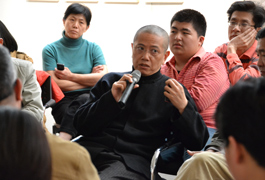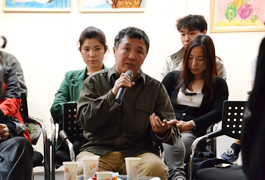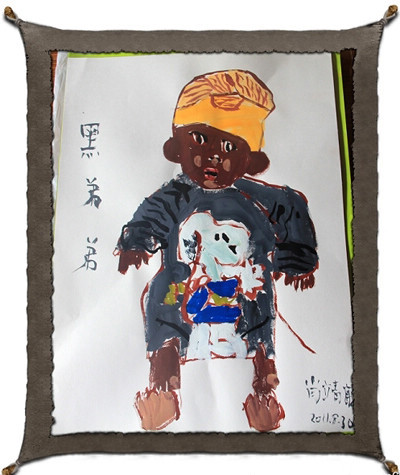|
 |
 |
|
ART MASTER'S ADVICE: Chen Danqing, a renowned oil painter, shares his advice on art and education with parents and teachers at a seminar at Beijing-based Inside-Out Art Museum on April 8 (LI FANGFANG) |
SHARING EXPERIENCE: Li Mu, a professor from the Academy of Art & Design Tsinghua University and father of an autistic child, gives his opinion on artistic education with other parents (LI FANGFANG) |
For autistic children fond of drawing, the fun of it is much more important than the benefit it may bring to them. This was agreed by most parents, teachers and artists when they discussed special education and the arts at a seminar at Inside-Out Art Museum in Beijing on April 8.
Children with autism typically exhibit impaired social interaction abilities marked by repetitive behaviors and narrow interests. Many of them cannot express their feelings through language or control their emotions like normal people. However, some of them are found to be talented and enthusiastic in music, fine arts and mathematics.
A small fraction of persons within the autistic spectrum exhibit special talents such as memorization of trivia or the ability to make rapid and accurate mathematical calculations. The education for children with autism shows the potential to unlock the talents of uniquely gifted but extraordinarily rare autistic savants and help children to improve their lives by learning how to cope with the disorder throughout their lives.
Because of autism, these kids totally focus on their feelings without disturbance from the external social world. They not only draw something but also tell their own story in this artistic way. "Their works are amazing!" said Chen Danqing, a famous oil painter. People cannot distinguish the autistic childrens' works of candid imagination from those of neurotypical children.
Dai Shihe, a professor of the China Central Academy of Fine Arts, said even talented art students may actually show a decline in drawing skills if after a period of training, suggesting a limit to the value of technical drawing skills. He expressed concern with how students are guided and coached by instructors.
An instructor of autistic children from north China's Inner Mongolia Autonomous Region shared a story. One of her students colored grasslands grey. She asked the student why. "Because they are roasting to death in the sun," the kid said.
She is becoming aware that kids naturally weave their feelings into drawing, a tendency that is a precious commodity in the arts. She refrains from providing orthodox technical instruction and instead guides them to feel things first by touching, smelling or tasting, and draw their feelings out.
Students draw happily, but parents can't understand what they are drawing. They think the objects in their kids' pictures don't look like anything in real life. Artists and teachers hold that realism is not as important as the fun of drawing for kids. It's fortunate for them to have found something they like and enjoy.
Most parents worry about autistic children's future. For those with artistic talents, can they make a living at it? Is it possible for them to get recognition from authority?
Parents are eager for educators to unlock their children's hidden talents and hold out the hope that their children may make achievements at or above the level of neurotypical children. The key issue of such worries is "whether parents have truly accepted the child's situation," said Chen, "If they have, they would let their kids just enjoy themselves."
 |
|
Black Brother, drawn by Xiao Jingkang, Zou Wen's son at 13-years-old (COURTESY OF ZOU WEN) |
Zou Wen, whose son has acute autism, told Beijing Review that it's very hard to face the truth of her son's illness. She used to tell him to draw real things as they were, resulting in mutual resentment. "Little by little, I just tried to understand him," Zou said.
Other parents have also come to understand the realities of autism and accept their sons and daughters after similar periods of struggle. Thus they draw together with their children by helping them to realize their dreams, for no matter how seemingly inconsequential, they are ultimately precious. | 